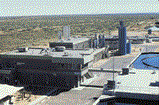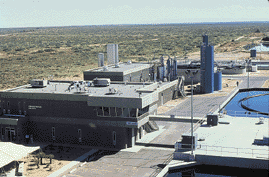Advanced Processes Allow Wastewater Plants to Produce Drinking Water Quality Effluents

Plant's Effluent Discharged to a Protected Trout Stream
In the early 1990s the management of the Milford-Trumbauersville Area Sewer Authority in Bucks County, PA, recognized the need to upgrade the existing wastewater treatment plant. Increased capacity was clearly required and more stringent requirements set by the Pennsylvania Department of Environmental Protection for discharge to a local stream, Unami Creek, were anticipated. The creek is said to be among a few in the country whose condition imposes challenging discharge limits as required by the National Pollutant Discharge System (NPDES) permit program.
The existing treatment plant had provided secondary biological treatment through the use of the extended aeration activated sludge process and tertiary filtration with sand filters. To upgrade the facility, the Authority retained Pennoni Associates of Philadelphia to perform engineering design and construction management for the construction of a one million-gallon-per-day addition. Plant Manager Lee Myers and his staff assisted the engineering team in investigating various tertiary filters that had performed successfully at other treatment facilities.
On the recommendation of the engineers, to increase the throughput of the plant the Authority added two additional circular clarifiers acquired from US Filter, Davco Products. The same company's Microfloc Products division supplied the Trident process that was selected for the advanced wastewater treatment section of the plant. In addition to its proven reliability and performance, this system had a small footprint and required no additional process air supply or associated electrical and control equipment.
Trident incorporates an upflow adsorption clarifier that combines flocculation and clarification in a single unit. It occupies less than 20% of the floor space nominally required for these process units installed separately in conventional plants. The adsorption clarifier uses special buoyant media that are rolled, scarified and held in place by a screen at the top of the system's containment tank. From the clarifier, the waste stream passes through the mixed media filtration chamber, after which it is collected by a Triton direct retention underdrain.
Wastewater produced by the filter backwash operations and the flush cycles of the clarifier is recycled to a settling basin. Subsequently, approximately 90% of this water is returned to the head of the Trident process for re-treatment.
The modified treatment train was put on line in late December of 1997. It has performed successfully, and its effluent discharge into the trout-laden Unami Creek is of high quality, meeting or exceeding in several ways the minimum drinking water standards. Perhaps most important is the fact that the upgraded plant has exceeded the contaminant removal expectations and requirements called for in the facility's NPDES regulatory permit.
Testing has shown that over 99.5% of all contaminants are removed from the waste stream prior to discharge to the creek, and phosphorus influent levels averaging nearly 7.0 ppm are reduced to below 0.3 ppm. Lee Myers commented that even when there are occasional upsets in the concentration of suspended solids in the secondary effluent, the final discharge shows no change in character.
Treated Wastewater Used for Aquifer Recharge
The second example of a wastewater plant producing a treated effluent of high quality—which is then used as a recharge source for a local aquifer—is found in El Paso, TX. This project got its start in the early 1980s when the El Paso Public Service Board decided to investigate the possible reuse of treated wastewater as a way to maintain adequate supplies of drinking water for the community.

Subsequently, the 10 mgd Fred Hervey Water Reclamation Plant was built, named in honor of a former El Paso mayor who also founded the Public Service Board. This facility was designed with some of the latest treatment technology available and has demonstrated the ability to produce finished water of drinking water quality over the long term.
Since full-scale operations started in 1985, the plant has run without a discharge permit violation and has met or exceeded the original design parameters. Plant Superintendent Javier Hernandez, who has worked at the plant since it went online, said the effluent water has consistently met state and federal drinking water standards.
The complete treatment arrangement includes wastewater and water treatment processes: screening, degritting, primary clarification, flow equalization, a two-stage PACT system, lime treatment, two-stage re-carbonization, sand filtration, ozonation, granular activated carbon filtration, chlorination, and finished water storage.
The PACT system, supplied by N/A unit in Rothschild, WI, is at the heart of the reuse scheme. This process uses powdered activated carbon and bacteria to accomplish aerobic treatment. Physical adsorption and biological assimilation occur simultaneously, enabling synergistic treatment to occur. The process removes most organic and all nitrogen compounds.
A new computer system for operational control has been added to the facility, but no changes have been made to the original process design. The current unit cost for treatment is about $1.60 per 1,000 gallons.
The plant's effluent discharge is used in two ways. One of these is for industrial purposes. The other makes use of the high quality of the discharge. Aquifer recharge is accomplished through a system of 10 injection wells, all of which reach 800 feet below the surface. Studies have shown that it takes about two years for the injected water to migrate across the aquifer to the potable water wellheads.
Edited by Ian Lisk, Editor Emeritus
